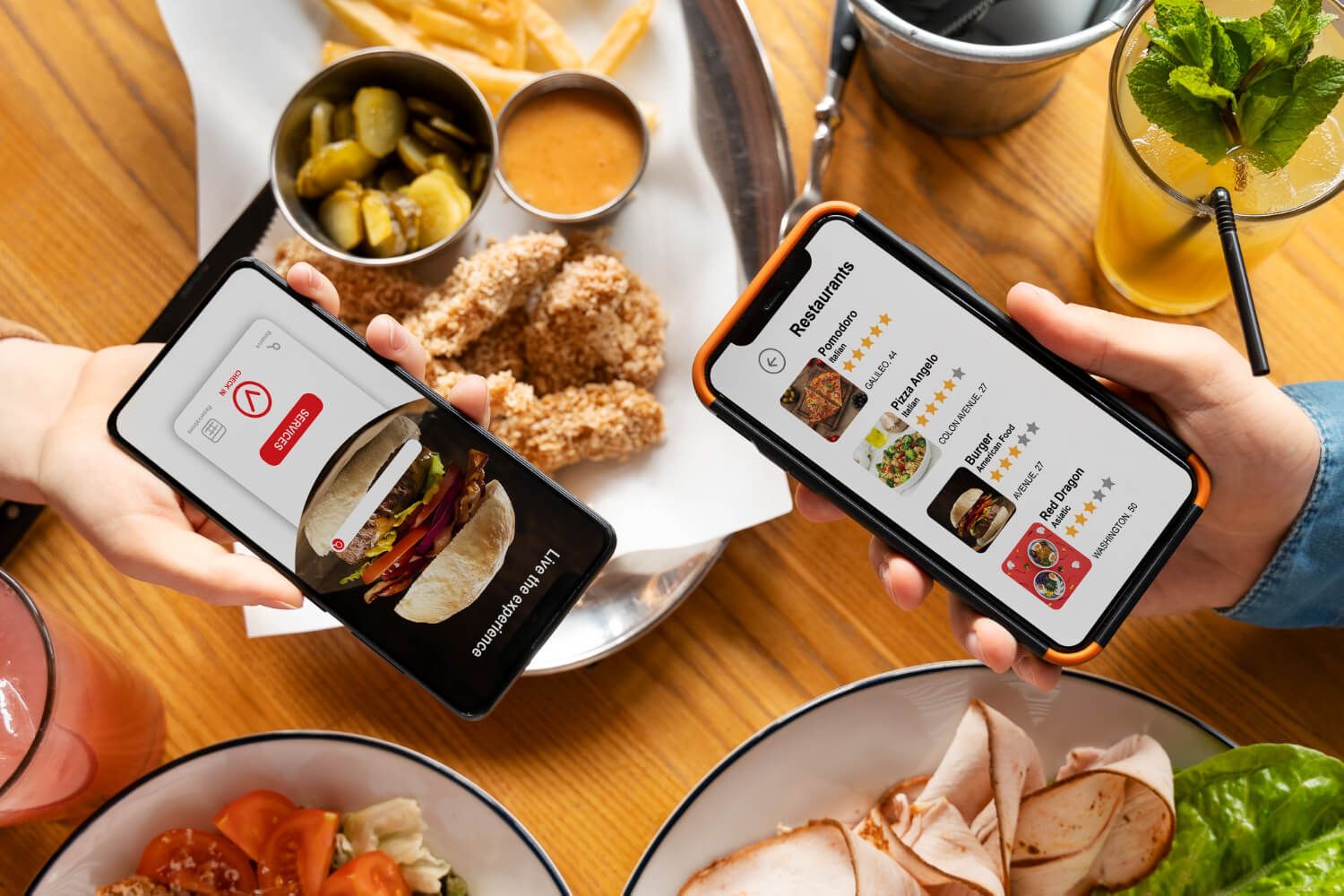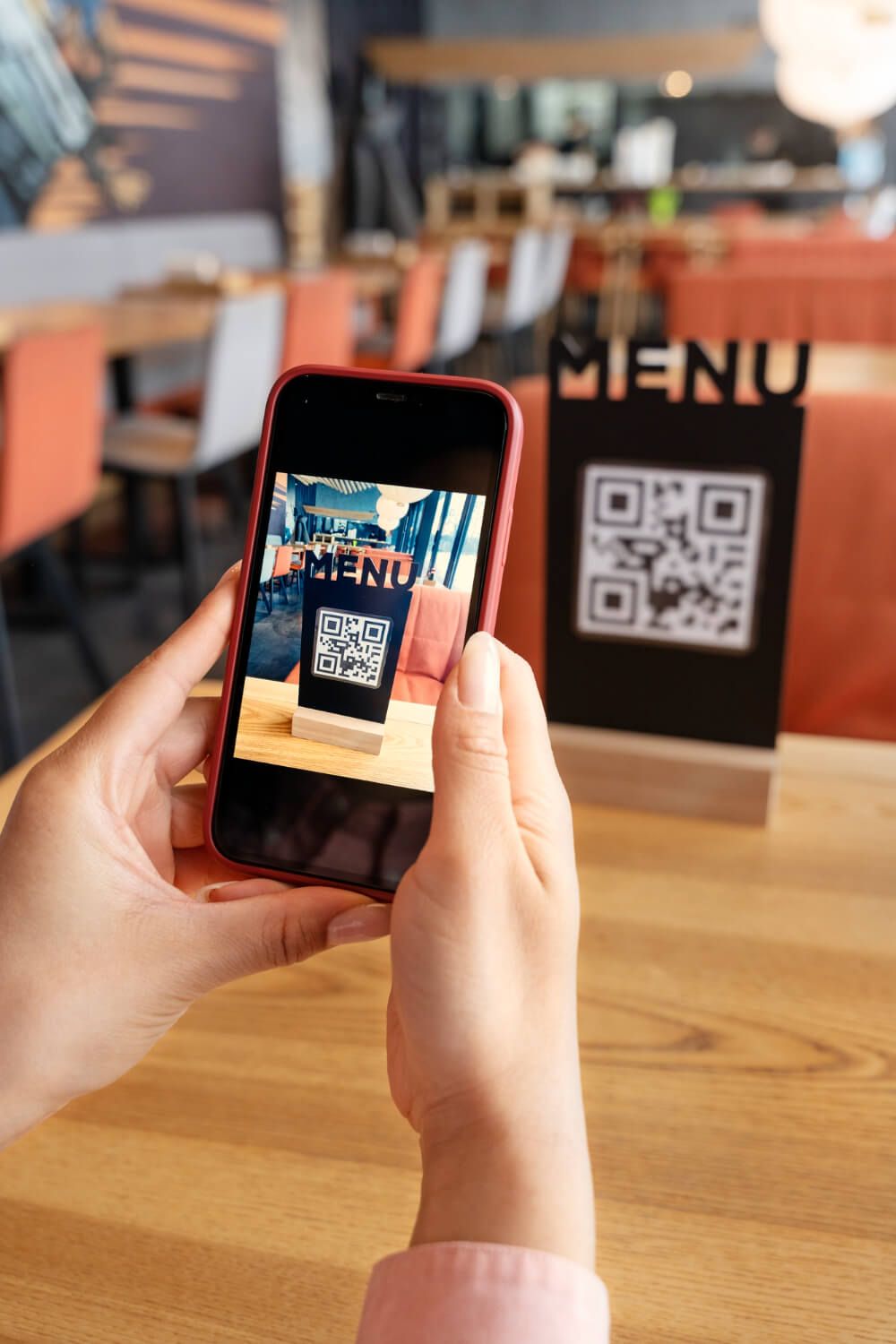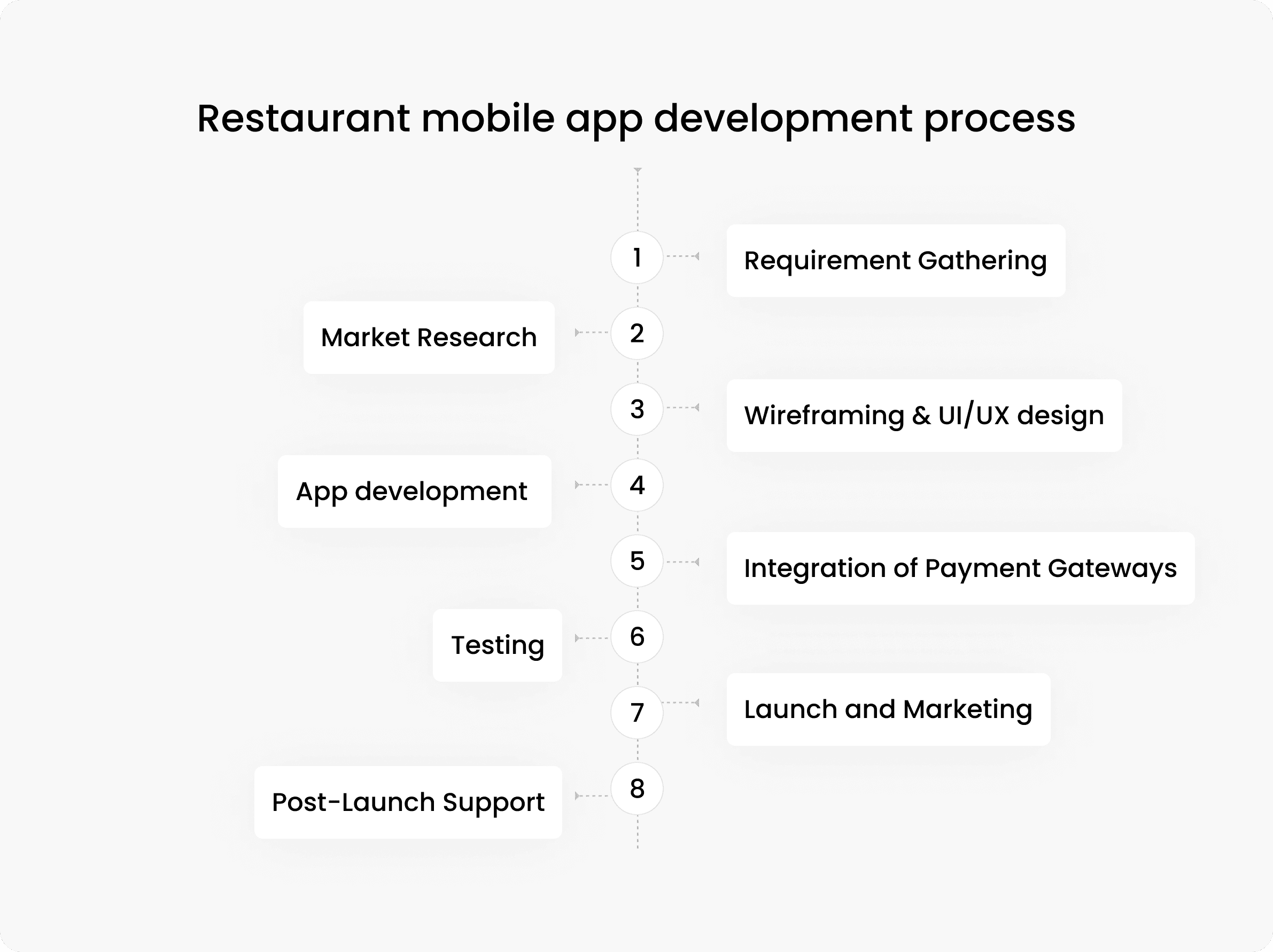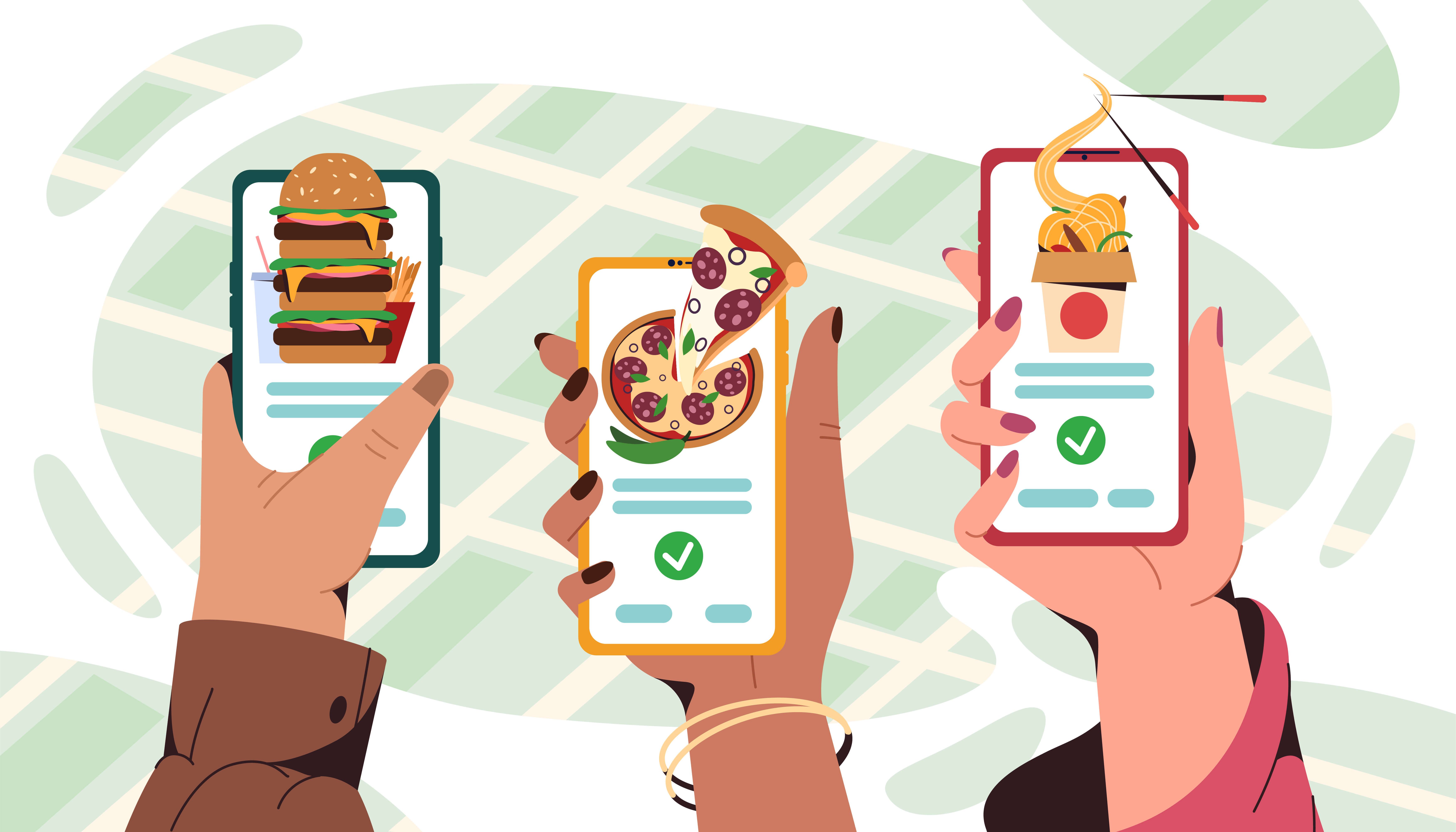Mobile App Development for Restaurants: Why It’s Worth the Investment
Nidhin N P
February 4, 2025
12 Min read

Over the years our dining experiences have changed rapidly, with consumers increasingly turning to restaurant mobile app development for their dining needs. Whether placing an order for delivery, booking a table for a reservation, or earning loyalty points, mobile apps have become essential tools for both restaurant owners and their customers. Research proves that 70% of consumers use mobile apps to order food. The reason for this shift is basically due to an unexpected catalyst—the 2020 pandemic.
As customers demand more convenience and personalized experiences, restaurants must be able to adapt, because more than 80% of the restaurant owners feel reaching through the channels that appeal better to the customers is better to improve brand recognition and sales. Mobile apps have grown to be a point to enhance the food industry as a whole. But what does the future hold for restaurant order management apps, and why is now the right time to invest in one?
Why Your Restaurant Needs a Mobile App?
-
Did you know?
The global online food delivery market is experiencing explosive growth with a market size accounted for USD 232.76 Billion in 2024 and is expected to be worth around USD 637.46 Billion by 2034, growing at a compound annual growth rate (CAGR) of 10.6% from 2024 to 2034. These numbers indicate a significant shift in consumer behavior; one that shows no sign of slowing down.
-
What’s your preference?
More than just a trend, almost 85% of independent adults now use smartphones to find restaurants, as 27% of U.S customers prefer using restaurant applications primarily for their convenience, and 22% for ease of use. Over 60% of consumers report they prefer ordering food via a mobile app.
-
How likely are you to order online?
65% of customers under the age of 30 preferred ordering online, 62% ordering by phone, 51% through a restaurant app, and 38% through third-party apps. Customers now expect an efficient dining experience that extends beyond the restaurant’s physical space, and the restaurant ordering apps make this possible. Whether it's quick ordering, personalized promotions, or loyalty rewards, a mobile app enhances every aspect of a customer’s experience, leading to higher satisfaction and, ultimately, increased revenue.
-
Do you rely on delivery services?
If you use platforms like Uber Eats, DoorDash, or GrubHub, you are not alone. These platforms alone account for billions of dollars in sales annually, with restaurants increasingly relying on these services to expand their reach and customer base. These statistics make it clear the mobile app revolution in the restaurant industry is a powerful force that shapes the future of dining. For restaurant owners, this is the perfect moment to utilize mobile apps to stay ahead of the curve and meet growing consumer expectations.
Types of Restaurant Apps
Having the right kind of mobile app for your restaurant can make all the difference. Each app serves a unique purpose, offering different features that can boost your restaurant’s operations and enhance customer experience. But which one should you choose?
-
Online Ordering Apps: Online ordering apps are essential for modern customers who value convenience and speed. These restaurant ordering apps allow users to browse the restaurant menu, select items, customize their orders, and pay—all within a few taps on their mobile devices. Research shows that restaurants with mobile ordering options see an increase in order size by as much as 20%. What’s even more impressive is that these apps can calculate delivery fees, suggest additional add-ons based on customer preferences, and manage complex orders, all while reducing human errors. Domino’s Pizza’s online ordering app is an example of this category that connects with their customers looking to satisfy their cravings without leaving the comfort of their homes
-
Reservation Apps: Nothing is more frustrating than showing up at your favorite restaurant only to find it’s fully booked, forcing you to wait in long lines or leave without dining. Restaurant reservation apps like OpenTable eliminate this problem by allowing one to secure a table in advance. This feature of restaurant table reservation apps not only saves time for the diner but also optimizes your restaurant’s operations by efficiently managing your seating arrangements, reducing wait times, and ensuring that customers don’t feel neglected. This leads to happier guests and better customer retention. It also provides your staff with real-time information about upcoming bookings, allowing them to prepare for busy periods. are a perfect example of this platform.
-
Loyalty and Rewards Apps: Who doesn’t love a good deal? Loyalty program apps for restaurants help you to keep your customers coming back. These apps reward repeat visits with points, discounts, and exclusive offers that customers can easily track and redeem. Starbucks' loyalty program, Starbucks Rewards, is a prime example. Customers earn "Stars" for every purchase made using the app or Starbucks card. Stars can be redeemed for free drinks, food, and exclusive merchandise. The restaurant loyalty app also offers personalized deals and birthday rewards, fostering a sense of exclusivity. With a well-designed loyalty program, you increase customer retention and build stronger relationships through personalized, rewarding experiences.
-
Restaurant Management Apps: Restaurant management apps are specifically designed apps for restaurant owners to handle the complex tasks involved in running a restaurant. Apps like Toast are excellent tools for restaurant owners who want to increase operational efficiency, reduce overhead costs, and optimize workflows. These apps are designed to the real-time inventory and alert you when supplies are running low. This means you won’t have to worry about running out of key ingredients in the middle of a busy service.
-
Delivery Apps: The rising demand for food delivery has made delivery apps essential in the restaurant industry. These apps bridge the gap between restaurants and third-party delivery services, allowing customers to conveniently order meals and deliver them to their homes. Delivery apps are advantageous for both restaurants and customers. Customers enjoy the convenience of doorstep delivery, while restaurants can expand their customer base and reach new markets without the overhead of in-house delivery staff. Additionally, platforms like DoorDash and Grubhub manage the delivery logistics and allow restaurants to offer special promotions and discounts to app users, further increasing sales.

- Menu and Digital Ordering Apps: Menu and digital ordering apps, are a key step for restaurants, looking to modernize their service. These apps offer interactive digital menus that customers can browse from their smartphones, customize orders, and access item descriptions and nutritional information. Eliminating the need for paper menus reduces waste and creates a more eco-friendly atmosphere. Digital menus are also versatile, allowing quick updates for seasonal specials, price changes, or item removal. Popular examples of restaurant digital menu apps include apps like GloriaFood and Chownow, which simplify the ordering process and provide customers with a seamless experience while boosting restaurant sales and efficiency.

Benefits of Creating a Restaurant App
Restaurant apps offer a range of benefits that enhance both customer satisfaction and business performance. Whether you’re looking to boost sales, ease out operations, or build stronger connections with your guests, here’s how a restaurant app development can help take your restaurant to the next level.
-
Enhanced Customer Engagement: Customers no longer view dining out as just about food; it’s about the experience. A restaurant app serves as the bridge between your business and your customers, giving you direct access to engage with them in real-time. Through push notifications, personalized promotions, and loyalty rewards, apps allow you to engage with your customers in a way that feels personal and immediate. Moreover, apps allow you to track customer preferences and habits, which means you can tailor offers and content specifically for them. This personalized touch not only strengthens the customer relationship but encourages repeat visits, creating long-term loyalty.
-
Improved Convenience: Consumers expect seamless, easy-to-use solutions in every aspect of their lives, and dining is no exception. A restaurant app makes dining out or ordering easier than ever, offering an array of features that simplify the process. With the ability to place orders online, book reservations instantly, and even make contactless payments, customers experience a frictionless journey from start to finish. Contactless payment options through the app increase hygiene and make transactions safer for both customers and staff. Whether a customer is dining in or ordering from home, they can rely on the app for an effortless, smooth experience.
-
Increased Revenue: A restaurant app can do wonders for your bottom line. By providing features like online ordering, upselling, and in-app payments, you make it easier for customers to spend more while making the ordering process faster and more efficient. When customers place orders through your app, they’re more likely to add additional items, these subtle suggestions encourage customers to increase their order size, often resulting in a higher average spend per visit or order.
-
Operational Efficiency: Managing a restaurant involves juggling multiple tasks at once; from order tracking to inventory management and staff scheduling. A mobile app can alleviate some of these burdens, making your operations more efficient. Many restaurant apps offer order tracking, allowing you to monitor orders in real-time, ensure timely preparation, and also automate inventory management, alerting you when stock is running low and reducing the chances of running out of critical ingredients. This feature is crucial for minimizing waste, optimizing supply orders, and preventing delays during peak times.
-
Real-Time Analytics: Analytics tools allow you to track various metrics, such as most popular dishes, peak ordering times, and customer feedback. Armed with this data, you can make more informed decisions regarding your menu offerings, pricing strategy, and staffing levels. Moreover, real-time data on customer reviews and ratings gives you instant feedback on what’s working and what needs improvement. By responding to customer feedback and continuously improving, you create a more customer-centric business model that thrives on satisfaction and loyalty.
-
Better Marketing Opportunities: Traditional marketing methods like flyers, posters, etc are becoming less effective now. With a restaurant app, you can have a treasure trove of data that lets you connect with your customers in a more targeted and impactful way. The app provides valuable insights into customer preferences, spending patterns, and location information you can use to create personalized marketing campaigns. Furthermore, you can tap into push notifications to keep customers informed about new menu items, limited-time offers, or special events. These timely messages grab attention, prompting immediate engagement. By understanding your customers’ behaviors through data analytics, your restaurant can offer deals that align perfectly with their needs, ultimately boosting sales and improving customer retention.
The Essential Features For A Restaurant App’s Success
A well-designed restaurant app is the foundation for improving customer experience and streamlining restaurant operations. Whether you're looking to attract more customers, increase sales, or optimize Back-end processes, the right features can make all the difference.
1. Basic Features Of A Restaurant App:
-
User Registration and Login: User profiles allow customers to create and store personalized information, such as their favorite dishes, frequent orders, delivery addresses, and preferred payment methods. This process makes future interactions much quicker and easier, eliminating the need to re-enter details for every visit. Additionally, this feature enables restaurants to send personalized offers based on a customer’s order history, preferences, or even loyalty points, increasing the likelihood of repeat business. It’s the ultimate way to make customers feel valued and appreciated, fostering a sense of familiarity and loyalty.
-
Menu Customization: Every diner has their preferences when it comes to food, and a menu customization feature gives them complete control over their order. Whether it's adding extra cheese, removing certain ingredients due to dietary restrictions, or requesting a dish be made spicier, customizing meals ensures that customers get exactly what they want. Not only does this feature enhance the customer experience, but it also helps reduce order errors, which can occur when relying on manual input. This functionality adds convenience and comfort, making it easier for customers to enjoy a meal that suits their tastes.
-
Order Tracking: Waiting for food to be prepared and delivered can be a bit of a nail-biter for customers. With order tracking, they are no longer left in the dark. Customers can see exactly where their order stands in real time, whether it’s in the kitchen being prepared, out for delivery, or ready for pickup. By integrating order tracking with an intuitive interface, your app enhances customer satisfaction by providing transparency and predictability. It also reduces the need for customers to make anxious phone calls to check on the status of their order.
-
Geo-Location Services: With geo-location services, customers can quickly find restaurants near them, making it easier to discover new places to eat or find the closest location for their go-to meals. For customers who are ordering delivery, geo-location services also allow them to track their meals in real time as they make their way to their door. Furthermore, geolocation can suggest nearby restaurants based on user location, making the app an all-in-one tool for exploring dining options, whether they’re ordering in or out.
-
Ratings and Reviews: Customer feedback is invaluable, offering essential insights for restaurants to improve their services. After dining, customers can rate and review their experience, including food quality, service, and app usability. This feature builds trust for future diners, who can read honest reviews before ordering. Positive feedback enhances credibility and attracts new customers, while constructive criticism helps identify areas for improvement. Engaging with feedback shows customers their opinions are valued and demonstrates a commitment to continuous improvement, fostering loyalty and elevating service quality.
-
Real-Time Delivery Tracking: Real-time delivery tracking elevates the convenience factor by allowing customers to see the exact location of their food as it’s en route. By providing a live map or real-time updates, customers can track their orders in real-time, enhancing the accountability of delivery services, which customers appreciate as it ensures timely deliveries and minimizes delays.
-
Contactless Payment & Digital Receipts: One of the biggest advantages of using a restaurant app is the ability to make contactless payments, customers can securely store their payment information within the app, whether they prefer using a credit/debit card, mobile wallet, or even contactless payment methods like Apple Pay or Google Pay. Additionally, the secure payment gateway ensures that all transactions are protected with encryption, giving customers peace of mind when making payments through the app.
2. Advanced Features Of A Restaurant App:
-
Augmented Reality (AR) Menus: One of the most exciting advanced features to incorporate into a restaurant app is Augmented Reality (AR). This feature allows customers to interact with the menu in a revolutionary way by visualizing food items in 3D before ordering. With AR, customers can see a real-life, interactive display of dishes, which makes choosing a meal more engaging and enjoyable. For picky eaters or those with dietary restrictions, AR helps them feel more confident in their choices by providing a clearer understanding of the meal.
-
Voice Command Integration: In an age of hands-free technology, voice command integration is becoming increasingly popular. By enabling customers to place orders or interact with the app through voice commands, restaurants offer an easier and faster way for customers to engage with the service, especially for those who are on the go or prefer hands-free interaction. Voice command technology is a breakthrough for busy customers, particularly those ordering takeout or delivery while driving or multitasking. It’s as easy as having a conversation with a server, but from the comfort of your own home or while on the move.
-
Loyalty Programs Integration: A 2024 Deloitte study shows that a loyalty program can increase customers’ lifetime value by 40% and is one of the most effective ways to ensure repeat business and reward your most loyal customers. By integrating a loyalty program into your restaurant app, you can encourage frequent visits and create a sense of exclusivity among your customers. Customers can earn points or rewards with every purchase they make through the app, which can later be redeemed for discounts, free meals, or special offers. Additionally, you can set up tiered programs that provide increasing rewards as customers spend more, further incentivizing higher spend amounts and repeat visits.
-
Social Media Integration: Social media integration within restaurant apps allows customers to easily share their dining experiences with their network. By enabling users to log in through their social media accounts like Facebook, Instagram, or Twitter, your restaurant app can encourage customers to share their meals, reviews, and memories with their friends and followers. Social media integration not only increases customer engagement but also acts as a powerful marketing tool for restaurants. When users share their experiences on social media, it provides free publicity and acts as a form of social proof.
-
AI-Powered Recommendations: Artificial Intelligence (AI) is transforming the dining experience by enabling restaurants to provide personalized recommendations based on a customer’s previous orders, preferences, and browsing behavior. Through AI-powered recommendation engines, restaurants can suggest the perfect meal, a new dish based on past favorites, or even offer personalized discounts.
-
Real-Time Inventory Management: Incorporating real-time inventory management into your restaurant app allows both restaurant owners and customers to stay informed about ingredient availability and menu changes. By providing live updates on the availability of menu items, customers can avoid the disappointment of placing an order for something that is out of stock. This feature can also help restaurants with inventory planning by providing insights into popular dishes, peak ordering times, and demand forecasting. By knowing which dishes are most popular and when restaurants can better manage their stock levels and reduce waste. Real-time updates can also be integrated with the app’s menu, allowing the kitchen to update the menu instantly in case certain items are unavailable.
Challenges of Restaurant App Development
Restaurant mobile app development opens doors to enhanced customer experiences and operations. However, it’s not without its challenges. As restaurant owners and developers venture into the world of mobile app creation, several hurdles need to be overcome to ensure the app meets both user expectations and operational requirements.
- User Experience (UX) Design:
The success of any app, including restaurant apps, hinges on user experience (UX) design. An intuitive user interface is essential to ensuring that customers can easily navigate through the app, place orders, or make reservations with minimal effort.
However, creating such an experience is no easy feat, especially when considering the wide range of users that will interact with the app. This means that the design must not only be visually appealing but also simple and intuitive and must cater to all levels of technological fluency. A cluttered interface, slow loading times, or overly complex navigation can quickly drive users away. It’s crucial to strike a balance between modern design aesthetics and ease of use to keep users engaged and satisfied. A great UX design anticipates customer needs and guides them effortlessly through the app’s functionality.
- User Acquisition:
With countless restaurant apps already on the market, standing out and convincing potential users to download and engage with your app can be a daunting task. Marketing strategies that rely solely on traditional methods might not be enough to attract the attention of today’s consumers. To successfully acquire users, restaurant app developers must implement innovative marketing tactics and create unique value propositions that set their app apart. Additionally, investing in local SEO and social media marketing can increase visibility and reach a broader audience. Encouraging existing customers to leave positive reviews on app stores or social platforms can also go a long way in building trust and attracting new users.
- Integration with Existing Systems:
For a restaurant app to be truly effective, it must integrate with the restaurant’s existing systems, such as the Point of Sale (POS) system, inventory management software, and other operational tools. This integration allows for real-time updates on orders, menu items, and customer data, ensuring everything runs smoothly behind the scenes. However, integrating the app with multiple systems often proves to be a significant technical challenge. Moreover, data synchronization between the app and restaurant systems must be flawless. If a customer orders a dish that is out of stock, it should be reflected immediately in the app’s menu. If a customer cancels an order, the app must communicate that change to the kitchen and POS system without delay.
- Scalability:
As your restaurant grows, so will the demands placed on your app. Scalability is a critical consideration when developing a restaurant app. As your restaurant adds new locations expands its menu offerings or grows its customer base, the app must be able to handle increased traffic and usage without compromising performance.
A scalable app can handle a growing number of users, support additional features, and expand functionality without requiring a complete overhaul. It’s important to plan for future growth by choosing a flexible tech stack and using cloud-based infrastructure that can easily scale to meet the increasing demands.
- Security Concerns:
Customers share sensitive information, such as payment details, personal preferences, and location data, every time they use the app. Failing to protect this information could lead to severe reputational damage, legal ramifications, and the loss of customer trust.
To address security concerns, developers must implement robust encryption, secure payment gateways, and two-factor authentication for user accounts. Data must be stored in compliance with industry standards, and users should be informed about how their data is collected and used.
- Maintenance and Updates:
Developing a restaurant app doesn’t end with its launch. Maintenance and updates are ongoing processes that are essential to the app’s success. Bugs, glitches, or performance issues can detract from the user experience, leading to negative reviews and frustrated customers. Regular updates help keep the app fresh, functional, and aligned with evolving customer expectations.
Continuous updates should focus on improving features, adding new functionalities, and fixing bugs as they arise. Seasonal promotions, new menu items, or special events should be reflected in the app in real time, keeping the app relevant and engaging for users. A well-maintained app is a secure, reliable tool that customers will continue to trust and use.
Process of Creating a Restaurant App

Restaurant mobile app development is no small feat, it’s a multi-step process that requires careful planning, attention to detail, and consistent effort.
- Requirement Gathering
The first and most important step in creating a restaurant app is defining the app’s goals, features, and target audience. This is where you build the groundwork for the entire development process.
Consider this step as the blueprint for your app, where you'll define the app's goals, features, and target audience, and set clear milestones and timelines. This groundwork will help manage expectations and track progress through each development phase. Start by listing out the core features; for example, do you want to include loyalty rewards or mobile payment options? Understanding your target audience is equally important. Ask yourself: who are the primary users and what are their pain points? Answering these questions ensures that your app's features align with user needs and business objectives.
- Market Research
With your goals set, the next step is market research. This phase involves understanding the competitive landscape and gaining insights into what works and what doesn’t in the restaurant app market. Start by analyzing competitor apps—what features do they offer? How do they engage users? What are the gaps in their app offerings that you can capitalize on? Don’t forget to explore customer reviews on app stores to see where other apps succeed and fail. Market research also involves understanding the latest tech trends in the restaurant and app development industries.
- Wireframing and UI/UX Design
After defining your app’s purpose and analyzing competitors, the next crucial step is designing your app. This starts with wireframing, which outlines the app's structure and user flow. A clean, intuitive layout is essential for restaurant apps, enabling smooth ordering and effective interactions. Next is UI/UX design, where the app's look and feel come to life. Visual elements such as color schemes, fonts, and icons should align with your restaurant's branding while remaining user-friendly. The UI should guide users effortlessly, while the UX focuses on smooth navigation, quick load times, and keeping customers engaged throughout their journey.
You may also like to read: https://pixbitsolutions.com/blogs/how-to-choose-ui-ux-design-agency
- App Development
With the design phase complete, it's time for app development, where your team turns designs into a fully functional app. Development typically follows two tracks: The front-end, which handles the user interface, and the back-end, which manages server-side logic, databases, and APIs. Choosing the right tech stack is crucial—whether native (Swift for iOS, Kotlin for Android) or cross-platform (Flutter, React Native) based on budget, time, and features. Regular communication between developers and stakeholders ensures alignment with project goals, efficient system integration, and compatibility with POS systems, inventory management, and payment gateways.
Technology Stack Used in Restaurant App Development
| COMPONENT | TECHNOLOGY |
|---|---|
| Front-end | React, Flutter |
| Back-end | Node.js, Laravel |
| Database | MySQL |
| Testing Software | Appium |
| Cloud Services | AWS |
| Geolocation | Google Maps API |
| Notification | Firebase Cloud Messaging |
- Integration of Payment Gateways
A crucial aspect of a restaurant app is integrating secure payment options. Customers need a smooth transaction experience, whether paying for meals or tipping delivery drivers. Integrating payment gateways should ensure secure, encrypted transactions, protecting both you and your customers from fraud. Your app should support various payment methods, including credit/debit cards, and digital wallets (Google Pay, Apple Pay). Instant payment confirmations build trust and satisfaction, while multi-currency options are valuable for international clientele or global locations.
- Testing
No app launch is complete without thorough testing. It's crucial to ensure the app works effectively across devices and operating systems, offering a flawless user experience. A comprehensive quality assurance (QA) process should cover performance, security, usability, and compatibility, checking for issues like slow load times, bugs, crashes, and broken links. Testing should also evaluate how the app handles real-time data, such as updating orders, tracking deliveries, or displaying menu items. Don’t forget user testing, by gathering feedback from real customers can help identify usability issues that developers may overlook.
- Launch and Marketing
Once your app is tested and optimized, the launch is just the beginning. Marketing it effectively is key. Start by creating pre-launch buzz through social media and email newsletters. Ensure your app is visible on all relevant app stores (iOS, Android) and encourage existing customers to download it. A solid digital marketing campaign can drive traffic, utilizing social media ads, influencer partnerships, SEO, and PPC. Offering discounts, free trials, or exclusive promotions can incentivize new users to download.
- Post-Launch Support
The work doesn’t end once your app is launched. Post-launch support is essential to ensuring that your app remains relevant, functional, and enjoyable to use. This phase involves monitoring app performance, addressing any issues that arise, and updating the app based on user feedback. Regular updates can introduce new features, improve security, and keep the app bug-free. Providing exceptional customer support ensures that users can resolve any issues quickly and efficiently, creating a positive relationship with your brand.
Restaurant App Monetization Strategies
Restaurant apps have emerged as essential tools for business growth. However, just having an app is not enough; it’s crucial to choose the right monetization strategy to maximize revenue.
- In-app purchases
In-app purchases allow restaurants to offer premium features or exclusive content that users can buy directly within the app. This could range from exclusive menu items, and premium loyalty benefits, to enhanced delivery tracking features. For example, Domino’s Pizza offers users the ability to customize their pizza and pay for additional toppings through their app, creating a direct revenue stream from user engagement.
- Subscription Models
A subscription-based model allows customers to access regular benefits or features for a monthly or annual fee. Restaurants could offer a subscription service that provides regular discounts, free delivery, or early access to new menu items. One well-known example is Panera Bread's "Unlimited Sip Club," which costs $12 a month and gives customers free drinks every two hours.
- Advertisement and Sponsored Content
In-app advertising or sponsored content is another viable monetization model. By allowing third-party businesses to advertise within your app, you can earn revenue without asking users to make purchases. Food delivery apps like Uber Eats and GrubHub utilize ads from restaurant partners, promoting special offers or new menu items.
Marketing the App To Drive Downloads
Launching a restaurant app is only half the battle. To ensure its success, you need a solid marketing strategy that will help you attract and engage users. The right marketing techniques will drive visibility, encourage downloads, and keep your app top of mind for customers.
- Social Media Integration
Social media platforms like Facebook, Instagram, and Twitter offer powerful tools for connecting with potential customers. By integrating social media into your app marketing strategy, you can boost brand awareness, encourage downloads, and increase engagement.
You may also like to read: https://pixbitsolutions.com/blogs/social-media-advantages-and-disadvantages-in-2024
Here’s how to leverage social media:
-
In-App Social Sharing: Allow users to share their dining experiences, favorite dishes, or restaurant specials directly from the app. This acts as a form of free advertising that helps spread the word about your app. Example: Domino’s Pizza encourages users to share their pizza creations on social media, creating excitement and brand loyalty while promoting their app.
-
Promotions and Giveaways: Run targeted social media campaigns offering discounts or exclusive promotions for users who download the app. For instance, you could offer a “Download the app and get 10% off your first order” promotion to entice new users.
-
Influencer Partnerships: Collaborate with local food bloggers or influencers who can review your app and highlight its features, such as easy ordering or exclusive rewards. Their followers will be more likely to check out your app if they trust the influencer's opinion.
- Email Marketing
Email marketing is an excellent tool for nurturing your user base and maintaining engagement with existing customers. By sending personalized and targeted email campaigns, you can drive app usage and encourage repeat business.
-
Personalized Offers: Use the data from your app to send personalized promotions to users based on their preferences. For example, if a user frequently orders vegetarian dishes, you could send them an email with a special offer on new vegetarian menu items.
-
Re-engagement Campaigns: Target users who haven’t interacted with your app in a while with tailored re-engagement emails. Offering a time-limited discount or exclusive loyalty points can be an effective incentive to bring them back.
-
Newsletters and Updates: Keep your users informed about new menu items, upcoming events, or app feature updates. This helps to build a loyal community of users who see value in staying connected to your restaurant via the app.
Example: Chick-fil-A effectively uses email marketing to inform app users about seasonal promotions, loyalty rewards, and exclusive offers, keeping their app users engaged and coming back for more.
- ASO for Mobile Apps
Optimizing your app’s presence in app stores is a critical part of app marketing. The more visible your app is in app stores, the more likely users are to find and download it. This process is called App Store Optimization (ASO), and it’s just as important as SEO for your website.
-
App Title and Description: Use relevant keywords in the app title and description that align with what potential users are searching for.
-
Optimized Keywords: Research the most searched terms related to food delivery or dining in your area. Implement these keywords strategically in the title, description, and tags to ensure your app shows up in the search results when users are looking for restaurant apps.
-
App Reviews and Ratings: Positive reviews and high ratings play a significant role in driving downloads. Encourage your satisfied customers to leave positive feedback, and respond to reviews to show your commitment to improving the app.
Example: Uber Eats and DoorDash are consistently visible in search results because of their optimized keywords and high-quality, informative app descriptions.
How Much Time Does It Take to Develop a Restaurant App?
The timeline for restaurant mobile app development depends on several factors, including the complexity of the features, the design, and the technologies used. Here's an in-depth look at how long it might take to develop your app, based on its complexity:
| Sl. No | BASIC APP | MID-RANGE APP | HIGH-END APP | |
|---|---|---|---|---|
| 1 | FEATURE SET | Offers all essential functionalities without too many frills.1. Menu Display2. Basic Online Ordering3. User Login/Registration4. Basic Payment Options5. Restaurant Details, Location andOther Contact Information | Offers a more feature-rich experiencethen a basic app.1. Order Customization2. Integration With Third-party DeliveryServices3. Loyalty And Reward Programs4. Secure Payment Gateways5. Push Notifications6. Social Media Integration | Offers a fully integrated, multi-functional, highly interactive app.1. AI-powered Recommendations2. Real-Time Tracking3. Advanced Loyalty Programs4. Integrated POS Systems5. Live Chat Support6. In-App Feedback & Reviews.7. Multi-Language Support |
| 2 | DESIGN & UX | 1. Basic, Templated Based Design2. Straightforward UX3. Minimal User Interactions | 1. Custom Design2. Standard UX Patterns3. Standard Animations & UI | 1. Highly Customized Design2. Unique UX3. Complex Animations & Advanced UI |
| 3 | PLATFORM SUPPORT | Single Platform (iOS/Android) | Cross-platform Support | Native Development For Multiple Platforms. |
| 4 | TIME FRAME | Development Time: 2-3 MonthsIncludes: Wireframing, Designing the UI,Coding, Testing, and App Launch | Development Time: 6-8 MonthsIncludes: More detailed design process,robust coding, testing, and debuggingprocess | Development Time: 9-12 Months Includes: Advanced feature integration,in-depth testing, and provides ongoing support and maintenance servicepost-launch. |
| 5 | FACTORS INFLUENCING COST | 1. Platform Choice 2. Levels of Customization Needs 3. Design Complexity 4. The number of third-party integrations 5. Size and expertise of the development team 6. Maintenance Plans |
Best Practices for Restaurant Apps UI/UX Design
When it comes to restaurant apps, the user experience (UX) and user interface (UI) design are just as important as the food you serve. The best UI/UX design practices can help your restaurant app not only stand out but also provide a seamless, enjoyable experience for your customers.
- Simple Navigation
The navigation of your restaurant app is the backbone of its user experience. If users can't quickly find what they’re looking for, they’re more likely to abandon the app in frustration. Simple, intuitive navigation ensures customers can seamlessly move between sections, such as the menu, order history, loyalty programs, or reservation system, without confusion. By simplifying your app's navigation, you reduce friction and help your users feel more in control, which leads to faster order placements, higher customer satisfaction, and more frequent app usage.
- Responsive Design:
In the digital world, users access restaurant apps across a wide variety of devices—smartphones, tablets, and even desktops. A responsive design ensures that your app adapts smoothly to different screen sizes, maintaining functionality, readability, and ease of use across all devices. With responsive design, you ensure your restaurant app is flexible enough to meet the needs of customers on any device, improving the overall user experience and ensuring your app reaches the largest audience possible.
- Visual Appeal:

Visual appeal is essential to attract the undivided attention of your customers. Striking visuals can capture attention and entice users, but they must be paired with an intuitive layout that prioritizes function. Balancing aesthetics with usability is key to ensuring users not only enjoy the design but also find it easy to navigate and interact with. The goal is to create a visually appealing restaurant app that not only looks good but also functions beautifully. A design that is both captivating and user-friendly is essential for increasing engagement and ensuring customers keep coming back.
- Personalization:
Personalization is a crucial feature that enhances the user experience. A personalized experience helps customers feel valued, leading to greater loyalty and satisfaction. Personalization is a win-win for both customers and restaurant owners. Customers enjoy tailored experiences, while restaurant owners can increase engagement, boost sales, and build long-term customer relationships.
Best Practices For Restaurant App Development
Building a successful restaurant app requires more than just creating a functional tool—it’s about crafting an engaging and seamless experience for your customers. Here are some essential best practices to guide you through the development process:
-
Prioritize User-Centric Design: A restaurant app should make the customer’s experience as easy and enjoyable as possible. User-centric design is about putting your customer’s needs first, ensuring that your app is intuitive, visually appealing, and user-friendly. A well-designed app not only drives customer satisfaction but also boosts retention and engagement. Think of your app as an extension of your restaurant’s atmosphere. The design should reflect your brand’s personality, whether that’s through colors, fonts, or imagery. This consistency helps customers feel connected to your restaurant even when they’re not dining in.
-
Implement Regular Updates and New Features: The digital world is constantly evolving, and so are your customers' expectations. A static app will quickly lose relevance. By continually updating your app with fresh features, you show customers that you're invested in enhancing their experience. Consider launching a “version update” campaign within your app. Use notifications or in-app messages to highlight new features, bug fixes, or seasonal specials. Customers love knowing they’re getting something new with every update.
-
Optimize for Performance: The performance of your app plays a huge role in customer satisfaction. Slow load times, crashes, and bugs can drive users away, leading to poor reviews and lost business. Optimizing your app for performance ensures it’s reliable, fast, and smooth—critical factors in keeping customers engaged. Incorporate real-time feedback features, such as progress bars or loading indicators, to keep users informed about the app’s status. Knowing that the app is working in the background while they wait will help maintain customer satisfaction.
-
Ensure Secure Payment Systems: Customers trust your app with sensitive information, such as credit card numbers, addresses, and personal details. A secure payment system not only protects your customers’ data but also boosts your restaurant’s reputation as a trustworthy business. Reassure customers by including clear security messages in the app. For instance, a small “secure payment” icon or a brief note about encryption can go a long way in building trust with your users. Transparency in security builds long-term loyalty.
Conclusion
A well-designed restaurant app does more than just offer convenience, it has the potential to revolutionize your business. By enhancing customer engagement, easing your operations, and providing valuable insights into customer preferences, a mobile app can become a vital asset that drives both customer satisfaction and revenue growth.
But a successful app isn’t built overnight. It takes the right blend of innovation, design, and functionality to create something that not only meets the needs of your business but exceeds the expectations of your customers.
Pixbit Solutions, the restaurant app development company in UAE specializes in developing custom restaurant apps that go beyond the basics. We understand that each restaurant has its unique set of challenges, goals, and customer base, and we work closely with you to craft an app that aligns with your brand and business objectives that not only solve the pain points but also make your customers feel valued and excited to engage with your brand.

Nidhin N P
Tech Lead at Pixbit Solutions
Share on
Have an idea that needs to go mobile? Launch it with us!
Have an idea that needs to go mobile? Launch it with us!
Let's Talk
You May Also Like
Explore insightful articles and tips from our experts on the latest trends in web development and marketing.
Have an idea ?
Let's make it happen
Tell us your business aspirations, and let's craft a custom solution that drives business growth, ensuring satisfaction and exceeding your goals with precision.
Let's Talk
